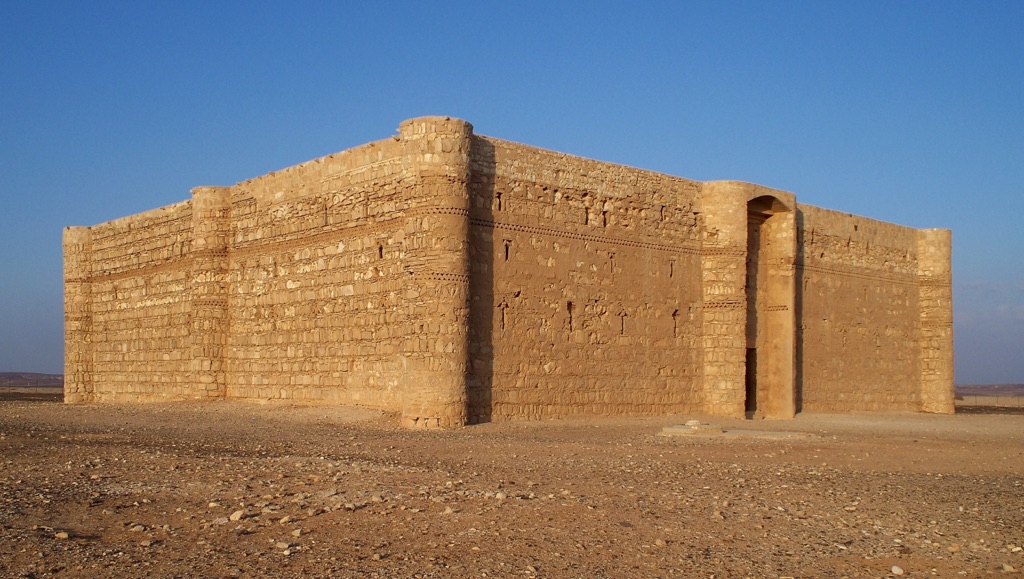Qasr Al-Kharranah is a captivating historical site located in the eastern part of Jordan. This desert castle, one of the earliest examples of Islamic architecture, stands as a testament to the region’s rich history. It is a two-story structure with a nearly square floor plan and features numerous rooms surrounding a central courtyard. Despite its castle-like appearance, its purpose remains a subject of debate among historians. Qasr Al-Kharranah’s remote location and well-preserved state make it a significant attraction for both scholars and tourists seeking to understand the early Islamic period.
Get your dose of History via Email
Historical Background of Qasr Al-Kharranah
The discovery of Qasr Al-Kharranah dates back to the early 20th century. Western explorers and archaeologists stumbled upon this desert gem, intrigued by its enigmatic presence. The exact date of its construction is uncertain, but evidence suggests it was built in the early Umayyad period, around the 8th century. The Umayyad Caliphate, a dynasty hailing from Mecca, is credited with its creation. Over the centuries, Qasr Al-Kharranah has witnessed various inhabitants, though it never served as a permanent residence.
The castle’s strategic location hints at its possible use as a caravanserai for travelers and traders. It also may have served as a military outpost, given its vantage point and defensive features. However, no battles or significant historical events are directly linked to Qasr Al-Kharranah. Its importance lies more in its architectural style and the insights it provides into the era’s construction techniques.
The Umayyads, known for their luxurious palaces and grandiose architecture, left behind Qasr Al-Kharranah as part of their legacy. The structure’s design deviates from traditional Roman and Byzantine influences, showcasing the emergence of a distinct Islamic architectural language. Despite the absence of lavish decorations, the castle’s simplicity and functionality speak volumes about the period’s aesthetic preferences.
Over time, Qasr Al-Kharranah has endured the harsh desert environment, remaining remarkably intact. This resilience has allowed historians and archaeologists to study its features in detail. The castle has not undergone significant alterations, preserving its original form for modern-day visitors. Its continued existence offers a window into the past, allowing people to step back in time and experience the early Islamic world.
Qasr Al-Kharranah’s historical significance is further enhanced by its inclusion in the Umayyad desert castles, a group of early Islamic buildings in the region. These structures collectively shed light on the Umayyad civilization’s prowess and the spread of Islam in the Levant. Qasr Al-Kharranah, with its enigmatic aura, continues to captivate those who explore its walls and corridors.
About Qasr Al-Kharranah
Qasr Al-Kharranah stands as a remarkable example of early Islamic architecture. The structure is predominantly made of limestone, a material readily available in the region. Its nearly square floor plan measures approximately 35 meters on each side, with a central courtyard that anchors the design. The castle’s two stories house around 60 rooms, which vary in size and function.
The building’s exterior is characterized by its high walls and four corner towers, which may have served defensive purposes. The entrance is a notable architectural feature, with its recessed doorway and modest decorations. Inside, the rooms are arranged around the open courtyard, providing a communal space that could have been used for various activities.
The construction methods of Qasr Al-Kharranah reflect the ingenuity of its builders. The use of barrel vaults and arches in the design demonstrates an understanding of weight distribution and structural integrity. The thick walls and small windows are well-suited to the desert climate, offering insulation against the heat and cold.
Despite its fortress-like appearance, Qasr Al-Kharranah lacks certain military features, such as battlements or a moat. This has led some scholars to suggest that its primary function was not defensive. The interior, devoid of elaborate ornamentation, emphasizes practicality and simplicity. The absence of a mosque within the complex is also noteworthy, as it deviates from typical Islamic architectural practices.
The architectural highlights of Qasr Al-Kharranah, such as its iconic doorways, towers, and the overall layout, have been well-preserved. This preservation allows for a detailed analysis of the construction techniques and materials used. The castle’s design has become a reference point for studying the transition from Byzantine to Islamic architecture in the region.
Theories and Interpretations
Qasr Al-Kharranah has been the subject of various theories regarding its original purpose. Some historians believe it was a caravanserai, providing shelter and respite for travelers and traders. The castle’s location along ancient trade routes supports this theory. Others argue that it may have been a retreat for the Umayyad elite, a place for hunting and leisure.
The lack of defensive fortifications has puzzled researchers, leading to speculation that Qasr Al-Kharranah was not a military stronghold. Its design, while castle-like, does not include typical defensive features. This has fueled the idea that it served a more administrative or agricultural role, possibly as a meeting place for Bedouin tribes.
Mysteries surrounding Qasr Al-Kharranah include the absence of a mosque and the purpose of certain architectural elements. Historians have had to interpret these anomalies by comparing the site to other contemporary structures. Theories are often cross-referenced with historical records to build a coherent narrative of the castle’s past.
Dating Qasr Al-Kharranah has involved various methods, including architectural analysis and the study of inscriptions. Carbon dating has not been extensively used, as organic material is scarce in the arid environment. Instead, researchers rely on the style of the building and historical texts to estimate its age.
The interpretations of Qasr Al-Kharranah’s purpose continue to evolve as new evidence emerges. Each theory contributes to a deeper understanding of the Umayyad period and the development of Islamic architecture. The castle remains an enigmatic piece of history, inviting scholars and visitors to ponder its secrets.
At a glance
Country: Jordan
Civilization: Umayyad Caliphate
Age: Approximately 1,300 years (8th century AD)

